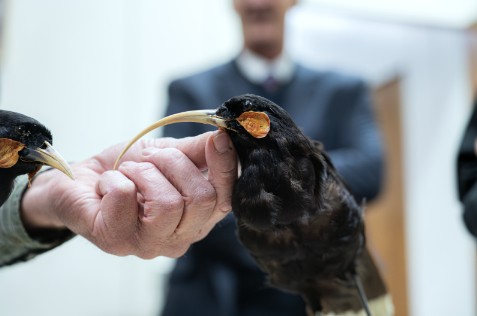
BYU alumni Nate and Sheryl Arrington made a generous donation of rare and extinct birds to the Bean Life Science Museum. Acquiring these birds from private collectors and museums that had shut down, the Arrington's donation includes several extinct bird species that hold important scientific and educational value: passenger pigeons, a male Carolina parakeet, heath hens (male and female), huias (a female and a male), additional huia tail feathers, and a waka huia (a hand-carved treasure box to hold huia feathers).
Huias are the most sexually dimorphic of any known bird species. The male’s beak is short and sharp, and the female’s beak is slender and elongated, both feeding on beetle grubs found underneath bark. Huias inhabited old-growth-forests on New Zealand’s North Island that provided abundant rotting trees. Due to the loss of habitat and overhunting, the Huia went extinct by 1907 but continue to hold a significant place in Māori culture.
Dallin Leota, Manager of BYU’s Lytle Preserve and a New Zealand-born Samoan, spoke to the cultural value of huias and their feathers: “Their feathers are invaluable to the Māori. They’re worn by chiefs and used at weddings and funerals; they’re passed down as family heirlooms.”

The Arringtons’ generous donation ensures that the stories and legacies of species like the Huia will continue to inspire and inform future generations.
“Adding the Huias to the museum helps preserve the scientific legacy of these unique birds and the rich cultural heritage they represent,” said Michael Whiting, Bean Life Science Museum Director. “Preserving and learning from the remarkable diversity of life lies at the heart of our mission as a university dedicated to the enhancement of the student experience.”
This generous donation will be properly curated, preserved, and studied. With recent advances in ancient DNA technology, these specimens may provide critical insight into the past genetic diversity of these species. The campus community can look forward to an upcoming “Exploring the Tree of Life” exhibit in 2026 which will display some of these and other fascinating specimens.

The Arringtons acquired these rare and extinct birds in the, “hopes that this will assure that the scientific value of these specimens are preserved.” At the Bean Life Science Museum, visitors will have the opportunity to reflect on the profound impact humans have on the natural world and the importance of safeguarding our planet’s biodiversity.